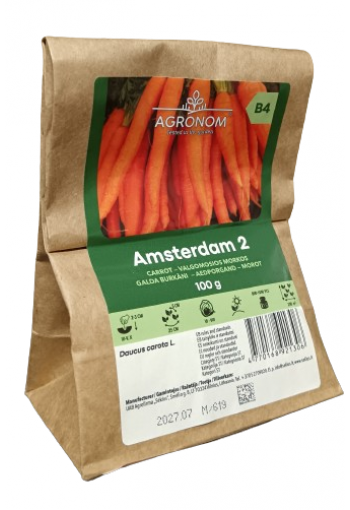Early variety.
Grows best in cultivated, humus, not soaked easy clay loam or sandy loam sols. If the soil is heavy – sprout bad, the root vegetables are short, branchy, split.
An early kind. The crop is harvested 80 days after germination. Root vegetables are cylindrical, 15-17 cm long, tapering with a blunt end.
The core is intangible, the flesh is dark red and juicy. Suitable for fresh consumption and short-term storage.
1,0 g contains approximately 800-1200 seeds.
What crops should be sown before winter and how to do it correctly?
Before the onset of persistent cold weather, it’s time to start winter sowing of cold-resistant plants.
WHERE? Choose a site for this in a high place so that in the spring it dries and warms up faster. Also, water should not stagnate on it.
WHEN? Approximately a week to a week and a half before the onset of cold weather (for Estonia) - in mid-October and until early November, when the soil temperature at a depth of 5 cm will be +2+4°C, and warming is no longer expected. In this case, the air temperature should be about 0°C.
HOW? The seeds are used completely dry - they are not soaked or germinated. They are sown along the furrows and sprinkled with a layer of earth, compost or peat 1.5-2 cm thick.
WHAT?
Carrot. The best time for sowing is the end of November in frozen ground (this way they have no chance of germinating ahead of time).
Leaf parsley - seeds germinate at temperatures from +2°C to -3°C, and sprouts can withstand temperatures down to -10°C. Autumn sowing guarantees faster results: the seeds of such greenery do not germinate very actively, and being in the ground, they will germinate much faster than with spring sowing.
Dill, end of autumn. The seeds will overwinter and begin to germinate when the temperature rises to +4-6°C. Spring frosts will not harm it. Good neighbors: cabbage, potatoes, carrots and cucumbers.
Coriander (cilantro) overwinters well in the soil and sprouts with the first thaw. In general, dill, cilantro and parsley can be sown throughout the summer so that fresh herbs are always present in the garden.
Spinach is a frost-hardy plant. Even if shoots appear by the time of the cold weather, it doesn’t matter, the greens can easily withstand down to -10°C. If the temperature drops below, and there are already sprouts in the garden bed, you need to cover them until it warms up.
Sorrel is so cold-resistant that the seeds can be sown in winter and the young shoots can be enjoyed as early as late March - early April.
Rhubarb is just the right plant to plant even in winter. Seeds are sown in frozen soil. And when propagating rhubarb by dividing the rhizomes, autumn planting is better.
Leaf lettuce is sown in autumn and young, juicy leaves can be cut off in early spring.
Radish. Cons: the plant may die in winter. But there are much more advantages. With this planting, the seeds will undergo hardening and only the strongest of them will sprout, resulting in exceptionally high-quality vegetables. Sowing is carried out in late autumn in frozen soil. It is important that the cold snap is not followed by a thaw, as it is detrimental to the plant. As the temperature rises, the seeds will begin to germinate and will not survive the winter.
Beet. Favorable temperature for sowing beet seeds is from -3°C to -5°C. After sowing, cover the beds with leaves or needles, this will help the plant to overwinter better. In spring, the cover must be carefully removed and the soil loosened. To ensure that the first shoots appear quickly, you can cover the beets with film, this will significantly speed up the process.
Important: it is necessary to mulch - this guarantees the safety of the seeds in the cold and the receipt of good and friendly shoots in the spring. Mulch consumption is up to 4 kg per m2.
Seed placement depth:
carrots 1-1.5 cm;
beets, leaf parsley, dill - 2-2.5 cm;
celery - the seeds are very small, so when sowing they are only sprinkled with compost/peat;
spinach 2.5-3 cm;
black onion - 1.5-2 cm;
leek 8-10 cm.
Choose early varieties for an early harvest. Regardless of what crops are planted before winter, the number of seeds when sowing must be increased by 30%.
If you have a greenhouse, you can sow mid-season varieties of white cabbage, leeks, celery, dill, coriander, radishes, and lettuce for seedlings.
Anything that can be planted in the fall will take root well, and you will be able to harvest on average 2 weeks earlier than after sowing in spring.
Undoubtedly, autumn sowing has its risks, but if you follow the rules and plant on time, you will not only get an early harvest, but also free up time for arranging the site and planting other plants in the spring.











